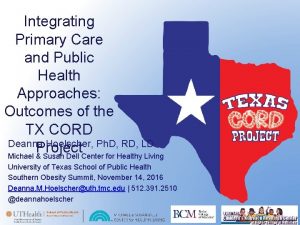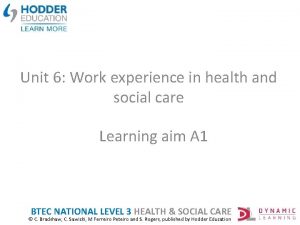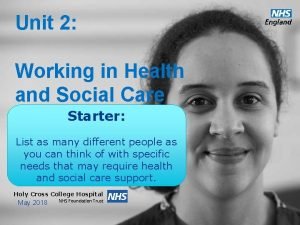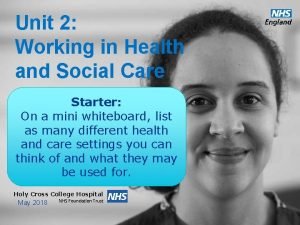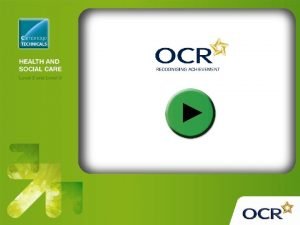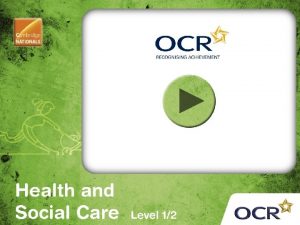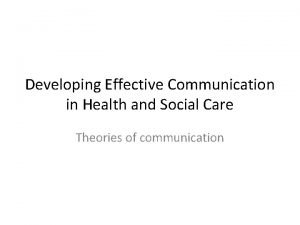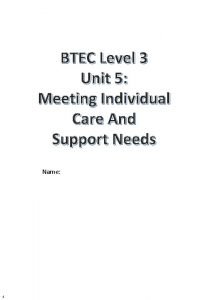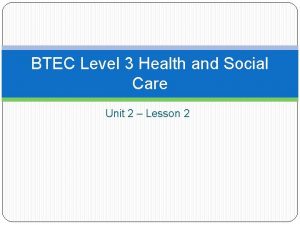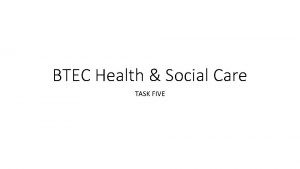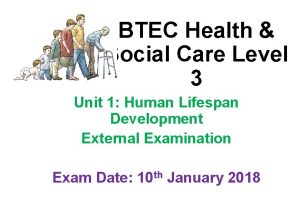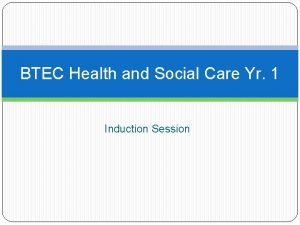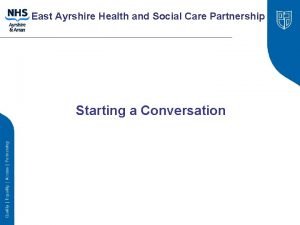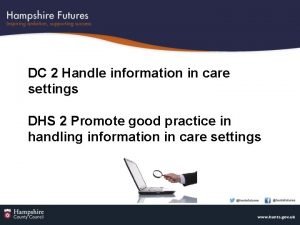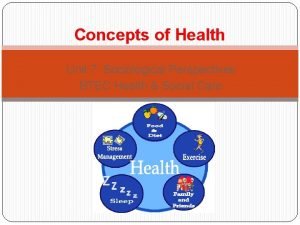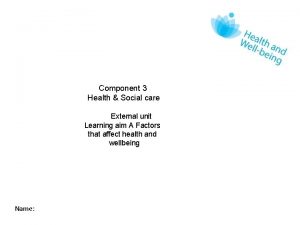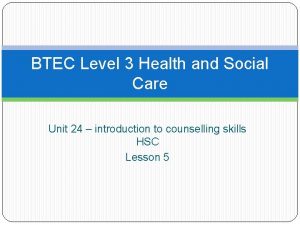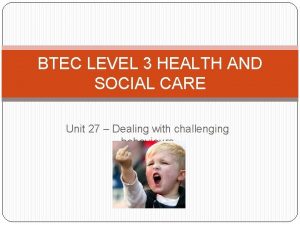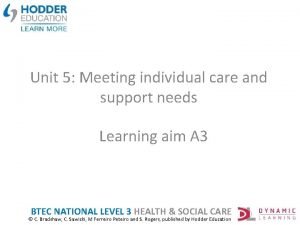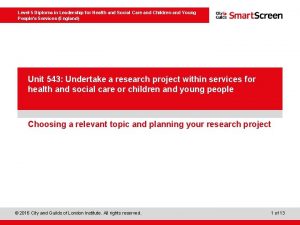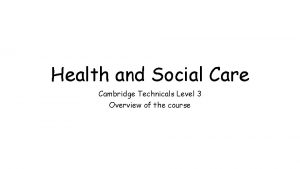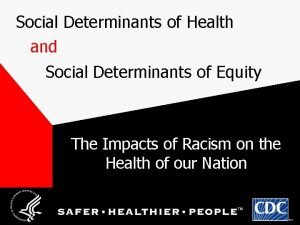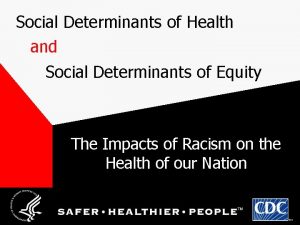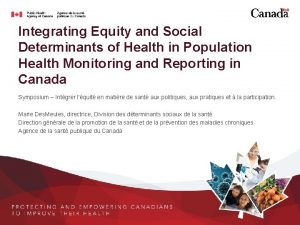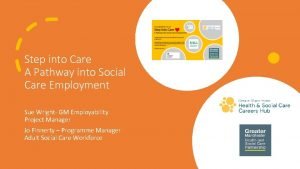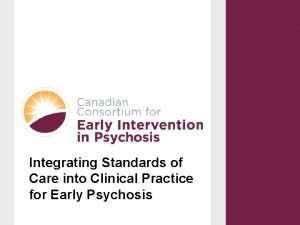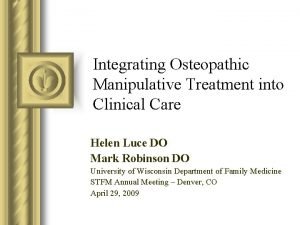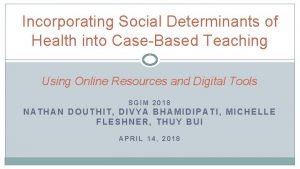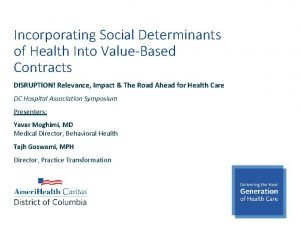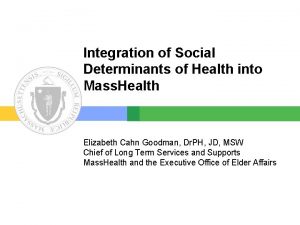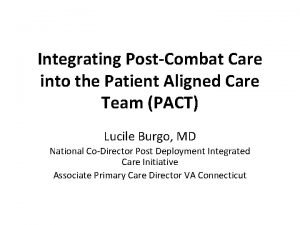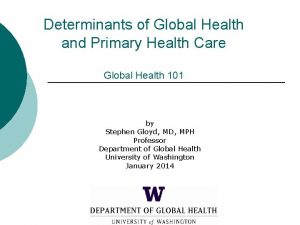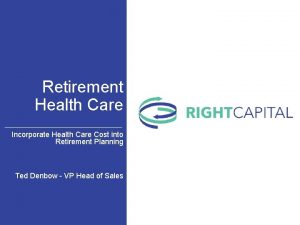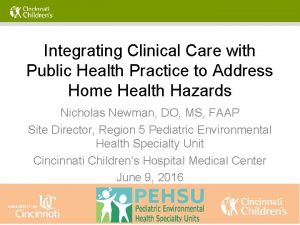Integrating Social Determinants of Health Into Clinical Care









































- Slides: 41

Integrating Social Determinants of Health Into Clinical Care Data, Research and Care Delivery Andrew Bazemore, MD, MPH Director, Robert Graham Center Visit with University of Utah March 2016


In an average month: 1000 people 800 have symptoms 327 consider seeking medical care 217 physician’s office 113 primary care 65 CAM provider 21 hospital clinic 14 home health 13 emergency 8 hospital New Ecology of Medical Care – 2000, NEJM <1 academic health center hospital

Our future must be team-based, and integrated with Public, Community and Behavioral Health • http: //www. annfammed. org/content/10/3/250. full

Large Implications for the effective Care of Complex Chronic Disease, which already principally occurs in PC

RGC has a longstanding interest in contextualizing health using GIS. . . And in linking clinical and population health data Street Addresses Streets/Rivers/Land Features Hospital/Medical Center/ Clinics Zip Codes/Counties Spatial Analysis – (i. e. travel times) Service Demand/Provider Density

…in effective data visualization…

Or combining multisource geospatial data to create an index of Social Deprivation and allow the better targeting of resources

Or in informing effective resource allocation to support the U. S. Primary Care‘Safety Net’

What % of Low-Income population remains unserved?

… or visualizing social accountability in Medical Education www. Med. School. Mapper. org


Or in helping Australia Understand its Primary Health Care Reform & the Quantum Shift to Population Based Health Care

Practice level Medicaid Data + Costs + Dz Prevalence + SDH


Can geographicallydirected prevention change outcomes?

…in support of local primary care development & advocacy Why should we support you? So many of your patients come from outside of DC” (DC City Council) Unity Service Area (2007) N= 77, 400 (Service Area Threshold 70%)

“Why have 2 sites in the same neighborhood? ” (Washington DC City Council) Hunt Place HC Service Area (2006) East of the River HC Service Area (2006)



…in their use for improvement of community health

and in the provision of Primary Health Care in a Community Context (Community Oriented Primary Care) Drs. Sidney and Emily Kark early 1940 s Developed COPC into a model of community engagement for improving health South Africa, Australia, Israel…. the US


Other Pioneers • Farley and Froom • Curtis Hames • Weed and Schultz

Contemporary Context

IOM Report: Social Determinants

Using Secondary Data instead of Patient Report?

Making sense of a tsunami of data

Opportunities in an age of Big Data & Geographic Information Systems Street Addresses Streets/Rivers/Land Features Hospital/Medical Center/ Clinics Zip Codes/Counties Spatial Analysis – (i. e. travel times) Service Demand/Provider Density

Our Approach



Our Approach

Community-level SDH domain Built Environment Example Indicators Data Source Environmental Exposures Percent of population potentially exposed Environmental Public Health Tracking Network, Environmental to water exceeding Protection Agency a violation limit during the past year Safe Drinking Water Information System, Environmental Protection Agency Overall percentile Agency for Toxic Substances and Disease Registry (ATSDR) ranking for the Centers for Disease American Community Survey Control Social Vulnerability Index -Neighborhood Stabilization Program, US Department of Housing & Urban Development Count and percent American Community Survey by race Neighborhood Economic Conditions Neighborhood Race/Ethnic Composition Population density American Community Survey U. S. Census Bureau, County Business Patterns U. S. Census Bureau, ZIP Code Business Patterns American Community Survey

Community-level SDH domain Neighborhood Resources Neighborhood Socioeconomic Composition Social Deprivation Index Example Indicators Data Source Urban Classification -Environmental Public Health Tracking Network, Environmental Code Protection Agency -Centers for Disease Control and Prevention -U. S. Census Bureau, County Business Patterns -U. S. Census Bureau, ZIP Code Business Patterns -U. S. Census Bureau; USDA Food Access Research Atlas -USDA Food Atlas -USDA, ERS Median household American Community Survey income A composite measure of social deprivation

Social Depreivation

SDH Library Geocoding API PRAPARE TOOL Analytic Tools Patient Reported SDH ACHIEVER Proposal (RGC/OCHIN) Community SDH Clinical Outcomes CLINCH-IT Outreach Point of Care Referrals/Clinic al Action Population Health Assessment Clinical Payment Policies/Risk Adjustment

What is next? • Working with OCHIN EHR vendors to embed this into one or more EHR interfaces • Using PCORnet to study SDH as a modifier • Grantwriting/studies to better understand use of integrated data

Summary • Social determinants of health significantly impact morbidity and mortality; however, physicians lack ready access to this information • “Community vital signs” can provide an aggregated overview of the social and environmental factors impacting patient health – To inform clinical recommendations for individual patients, – To facilitate referrals to community services, – To expand understanding of factors impacting treatment adherence and health outcomes. – To help care teams target disease prevention initiatives and other health improvement efforts for clinic panels and populations.

Summary • Advances in big data, geospatial technologies, and democratization of data make integrating Community VS into practice data, enterprise research data, and practicelevel decisionmaking • The science guiding the use of SDH in practice and patient-level decisionmaking is scarce. – We must build the tools and the science simultaneously

Who We Are: A Family of. Questions? Primary Care Scholars • 115 Larry A. Green Visiting Scholars • 12 Robert L. Phillips Policy Fellows – Dr. Laura Makaroff, now a Medical Officer for HRSA Bureau of Primary Care
 Integrating public health and primary care
Integrating public health and primary care What are the 6 main social determinants of health?
What are the 6 main social determinants of health? Care value base health and social care
Care value base health and social care Health and social care component 3 health and wellbeing
Health and social care component 3 health and wellbeing Hip fracture clinical care standard
Hip fracture clinical care standard How do you lead into a quote
How do you lead into a quote Paragraph writing
Paragraph writing Integrating science and social studies
Integrating science and social studies Levels of nursing care primary secondary tertiary
Levels of nursing care primary secondary tertiary What is physical environment
What is physical environment Social determinants of personality
Social determinants of personality Social determinants of aggression
Social determinants of aggression Btec health and social care level 3 unit 6: work experience
Btec health and social care level 3 unit 6: work experience Unit 2 working in health and social care
Unit 2 working in health and social care Unit 2 working in health and social care past papers
Unit 2 working in health and social care past papers Unit 14 physiological disorders health and social care
Unit 14 physiological disorders health and social care Wholly nutritious btec business
Wholly nutritious btec business Ocr health and social care level 2
Ocr health and social care level 2 Cambridge national health and social care
Cambridge national health and social care Johannes volkelt theory
Johannes volkelt theory What is appraisal in health and social care
What is appraisal in health and social care Ro23 health and social care
Ro23 health and social care Greater manchester health and social care partnership
Greater manchester health and social care partnership Communication groups
Communication groups Unit 5 health and social care checklist
Unit 5 health and social care checklist Health and social care level 3 unit 2
Health and social care level 3 unit 2 What is intellectual development in health and social care
What is intellectual development in health and social care Unit 12 health and social care level 3
Unit 12 health and social care level 3 Unit 5 health and social care assignment
Unit 5 health and social care assignment Unit 27 health and social care
Unit 27 health and social care Unit 14 learning aim d health and social care
Unit 14 learning aim d health and social care Btec
Btec East ayrshire health and social care partnership
East ayrshire health and social care partnership Handling information in health and social care
Handling information in health and social care Unit 7 health and social care
Unit 7 health and social care Health and social care component 2 learning aim b example
Health and social care component 2 learning aim b example Verna and sam
Verna and sam Btec level 3 health and social care unit 5
Btec level 3 health and social care unit 5 Btec level 3 health and social care unit 4
Btec level 3 health and social care unit 4 Unit 5 meeting individual care and support needs assignment
Unit 5 meeting individual care and support needs assignment Unit 543 research project examples
Unit 543 research project examples Cambridge technicals level 3 health and social care unit 2
Cambridge technicals level 3 health and social care unit 2
